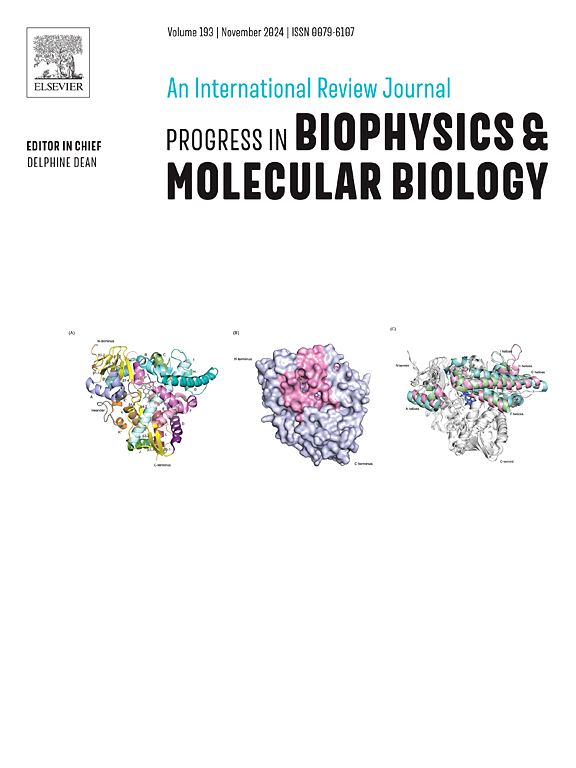The key role of Piezo1 channels in ferroptosis after spinal cord injury and the therapeutic potential of Piezo1 inhibitors
IF 4.5
3区 生物学
Q2 BIOCHEMISTRY & MOLECULAR BIOLOGY
Progress in Biophysics & Molecular Biology
Pub Date : 2025-05-06
DOI:10.1016/j.pbiomolbio.2025.05.001
引用次数: 0
Abstract
Background
Ferroptosis has been confirmed to be one of the key mechanisms of neuronal injury and dysfunction after spinal cord injury (SCI). Mechanical stresses such as deformation, compression, and stretching not only directly cause physical damage to spinal cord tissue at the moment of SCI, but also promote the development of ferroptosis through various pathways. However, the mechanism of ferroptosis after SCI remains unclear, which hinders the development of therapeutic methods.
Objective
This article aims to review the key mechanisms by which mechanical stress affects ferroptosis after SCI, including its impact on the structure and function of the endoplasmic reticulum (ER) and mitochondria, its role in triggering inflammatory responses, and its activation of mechanosensitive channels. Special emphasis is placed on the role of Piezo1 channels, which are key factors in cell mechanosensation and ion homeostasis regulation. The review explores how Piezo1 channels are upregulated by mechanical stress after SCI and participate in the ferroptosis process by mediating ion flow and other mechanisms.
Conclusions
Inhibiting Piezo1 channels may be a potential therapeutic strategy for SCI. This review summarizes the therapeutic potential of Piezo1 inhibitors by sorting out existing studies, hoping to provide a theoretical basis for effective therapeutic strategies targeting ferroptosis after SCI.
Piezo1通道在脊髓损伤后铁下垂中的关键作用及Piezo1抑制剂的治疗潜力
背景:铁下垂已被证实是脊髓损伤(SCI)后神经元损伤和功能障碍的重要机制之一。变形、压缩、拉伸等机械应力不仅直接造成脊髓损伤瞬间脊髓组织的物理损伤,而且通过多种途径促进铁下垂的发生发展。然而,脊髓损伤后铁下垂的机制尚不清楚,这阻碍了治疗方法的发展。目的综述机械应力影响脊髓损伤后铁吊的主要机制,包括机械应力对内质网和线粒体结构和功能的影响、机械应力在引发炎症反应中的作用以及机械敏感通道的激活。特别强调的是Piezo1通道的作用,这是细胞机械感觉和离子稳态调节的关键因素。本文探讨了脊髓损伤后机械应力如何上调Piezo1通道,并通过介导离子流动等机制参与铁凋亡过程。结论抑制Piezo1通道可能是一种治疗脊髓损伤的潜在策略。本文通过对已有研究的梳理,总结了Piezo1抑制剂的治疗潜力,希望为制定针对脊髓损伤后铁下垂的有效治疗策略提供理论依据。
本文章由计算机程序翻译,如有差异,请以英文原文为准。
求助全文
约1分钟内获得全文
求助全文
来源期刊

Progress in Biophysics & Molecular Biology
生物-生化与分子生物学
CiteScore
8.60
自引率
7.90%
发文量
85
审稿时长
85 days
期刊介绍:
Progress in Biophysics & Molecular Biology is an international review journal and covers the ground between the physical and biological sciences since its launch in 1950. It indicates to the physicist the great variety of unsolved problems awaiting attention in biology and medicine. The biologist and biochemist will find that this journal presents new and stimulating ideas and novel approaches to studying and influencing structural and functional properties of the living organism. This journal will be of particular interest to biophysicists, biologists, biochemists, cell physiologists, systems biologists, and molecular biologists.
 求助内容:
求助内容: 应助结果提醒方式:
应助结果提醒方式:


